The Lenovo ThinkStation P900 Workstation Review: Design 101
by Ian Cutress on May 6, 2015 7:00 AM ESTVisual Inspection
The base system is just over two-feet long at 24.4 inches, while being 17.5-in high and 7.87-in wide. Moving outside ecosystems where 1.5 liter chassis exist, the 55 liter workstation is a behemoth by comparison. 7.87 inches high converts to 4.5U for racks, perhaps indicating at what level Lenovo is positioning the P900. Carrying our workstation sample, even with only an M.2 SSD and one GPU was still an effort, with the chassis being made from a combination of steel for strength and aluminum for looks.
Opening the side panel via the latch shows of the internals. Similar to when we saw the initial renders of the P900, we get the three level split airflow in order to keep the system cool. For the top and bottom, air comes in the front via the fans in the middle of the case, over the storage drives, and out the rear past the PCIe coprocessors. In the middle, the CPUs use a rear case fan to draw air in, split the airflow independently across the CPUs and DRAM, and then out the front of the case around the sides of the ODD bays.
The air baffle for the CPUs is easy to take out via the handle provided.
On the side of the handle, here shows the split for the top and bottom, with the air from the top going to the furthest CPU from the rear of the case.
It is a little difficult to characterize in pictures, but the principle is sound.
For the central airflow, where the air from the CPUs moves around the ODD bays, we have the required space:
With the baffle removed the custom motherboard shows both CPUs in a linear design with four banks of DDR4 either side of each socket. Normally we see CPUs staggered to aid in design of the motherboard, but this application suits the Lenovo airflow management.
Each CPU is served by a six-phase server-grade power design to ensure efficiency and longevity. These are Cooper-Bussmann chokes, similar to those used on some of the consumer grade motherboards tested which focus on server-level longevity. As there is no overclocking on this platform, there is little need to over-engineer this aspect of the design. There’s a hint of cable management coming through between the sockets due to extra cabling required at the bottom of the motherboard. Lenovo has this fixed down as to not be effected by other components – the CPU fans are also equipped with fan guards so if the cable does come loose, it doesn’t start grating against the fan blades.
Installed in this system is the Quadro K5200 mentioned in the introduction. This is a standard NVIDIA blower design with no backplate and requiring double slot width. This card is using the lower down PCIe slot, but there is space just below the DRAM slots for another. If this was installed in that position, the position of the PCIe cables would affect the FLEX module installed on the right.
The FLEX module sits in a PCIe x8 slot alongside the main PCIe x16 slots, and is designed to be easily removable with the latch next to it. This card is in the right way round, although the server admin will have to remove it to see the bounty underneath:
It splits into two PCIe 3.0 x4 M.2 slots, although Lenovo can provide a range of FLEX modules to suit the customer requirements. To be honest, this is a nice way of putting in storage, especially for OS and fixed drives, into a high end workstation like system.
The drive supplied in our system was the 512GB model of the XP941 from Samsung, rebranded slightly with Lenovo product codes in case of replacement.
Where the FLEX module sits in the motherboard actually covers some of the cabling underneath, but putting the module back into place was easy due to the chassis design.
Next to this is one of the system fans. Rather than be placed right in the front of the chassis blowing air from the front to rear, these sit in the middle between the storage drives and the PCIe coprocessors and can be removed very easily by pulling the handle at the red stripe.
The fans are guarded on the open side and use Lenovo’s interesting fan connector in order to slot in. No screws are required. The fan used here is an AVC DBTA0938B2U, a 92x92x38mm fan which can use a fair amount of power at full load. Even with the side panel off I never heard the fan move above a low hum, even when hammering the system. That being said, this fan has to be able to cope with a fully laden system in a hot climate which might initiate a higher speed profile.
Similarly, the top strip has an identical fan as well as space for another FLEX module.
At the top we find the 1300W power supply, removable in one action by lifting the lever with the red strip.
Before we get to the power supply itself, this is how it connects directly into the system. We have a direct line in on the motherboard which looks like (but isn’t) a PCIe slot as well as a series of headers screwed into the case for external connectors. Through these two inputs/outputs, the system power needs of the components (motherboard, CPUs, drives, PCI coprocessors) are handled.
The connectors on the power supply also look deceptively like a 20+4 pin power connector and a PCIe port.
To the user on the outside it looks very simple, with a single 3-pin lead requirement. The power supply also supports a power self-test mode, presumably indicated by the green and amber lights beside the power socket.
The two fans at the rear of the power supply in the case ensure that airflow is from front to back based on the units orientation.
The sticker on the top indicates that this power supply is a Delta Electronics unit that satisfies the 80 PLUS Platinum standard, giving 90-92-89 percent efficiency at 115V and 90-94-91 percent at 230V (based on 20-50-100 percent loading). Interestingly the way this sticker is written seems that the power supply has a total of nine voltage rails, each limited to 18A.
Moving back inside the case, this is the side fan for the processors that interacts with the air baffle. It is easily removed by pulling on the red strip:
But the reason to take it out is to get a better look at the connector Lenovo is using for these fans.
The standard 4-pin fan header is moved into a bulkier 2x2 arrangement. On the motherboard, this looks like this:
Which is rather bulky and we won’t see it on anything designed to be commercial any time soon. As Lenovo is designing the whole system, they can almost afford to be liberal with PCB area. It is also worth noting that the power delivery cooling heatsink has a small cut-away in order to fit the fan.
The rear fan supplying the processors with cooler air is an AVC DV12038B12M, a 12cm ball bearing design to which there is very little information online.
For the PCIe slots under this fan, Lenovo uses a latch mechanism to keep the PCIe coprocessors in place. Pulling on the red strip opens the part up and the card is easily removed:
Similarly at the top, although only three PCIe slots are present here allowing for a big co-processor and a smaller connectivity card. The PCIe 2.0 x4 slot is open ended, allowing for bigger cards at reduced bandwidth.
On the other side of the chassis are the ODD bays. There are three possible, with one of our sample loaded with a DVD/RW drive. Rather than going for slim bays, these are full on allowing for other devices that require the room. The drives can be removed by pulling on the tag with the red arrow below the drive.
For people who want to add more drives in this area, the SATA ports are found beside the FLEX module on the bottom of the board, though it should be noted that only a few are available:
For storage drives, the P900 chassis comes beautifully equipped on the far right hand side. There is even a handy diagram to follow:
This allows for a 3.5-inch, a 2.5-inch or a combination to be used per bracket. These brackets have their own SATA and power connections already pre-attached, allowing them to be installed quite easily.
The brackets themselves are plastic, requiring the built in push-pins to put the drives in:
That almost sums up the design of the system, with a couple of final images confirming the SK Hynix DRAM:
As well as the side panel containing an easy to use diagram of what goes where in the motherboard:
In The Box
The box contents for the P900 match those for the P300 – at a basic level we get a bundled mouse, keyboard, power cord and operating system/recover disks. Because Lenovo provides the systems as ‘Windows 8.1 downgraded to Windows 7’, it means the price of our sample comes with 8.1 should the user want it, but it ships with Windows 7 as the operating system at boot. Going back up to Windows 8.1, or a fresh install, requires these disks.


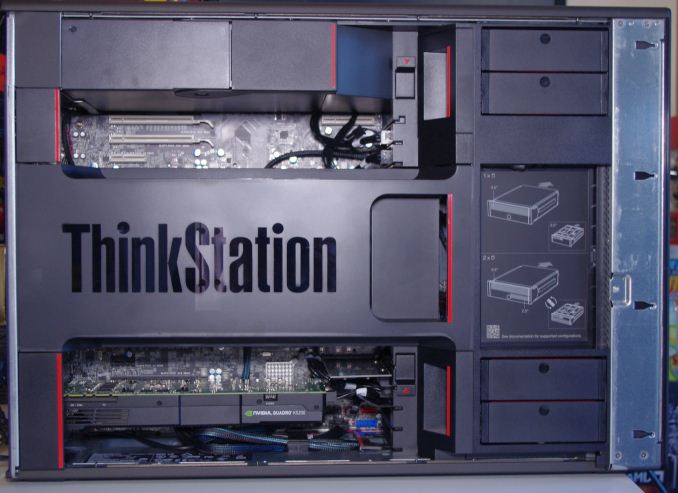
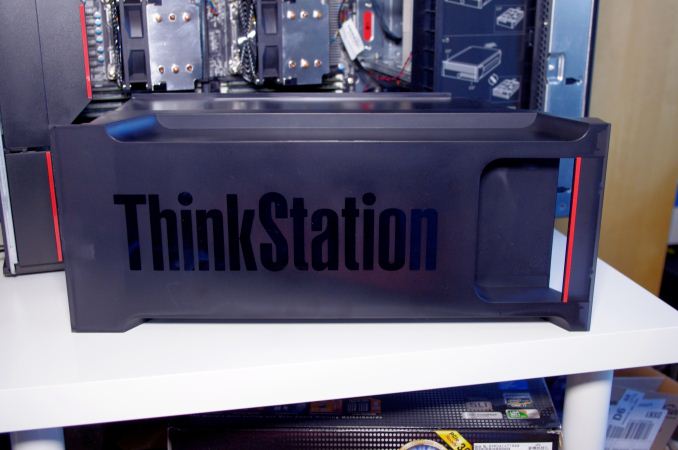
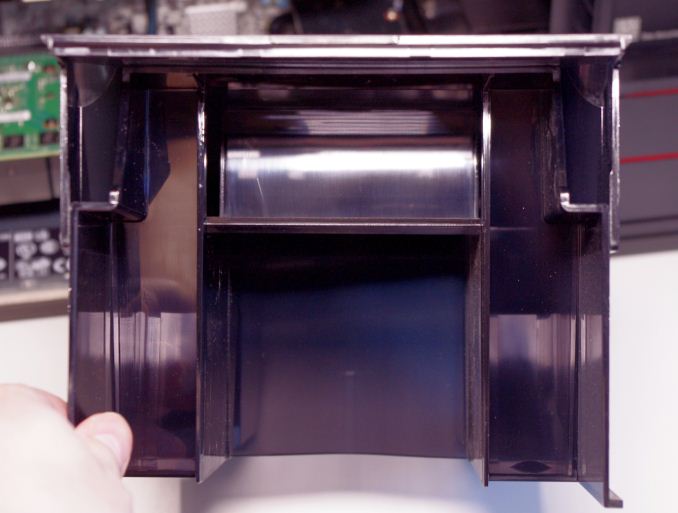
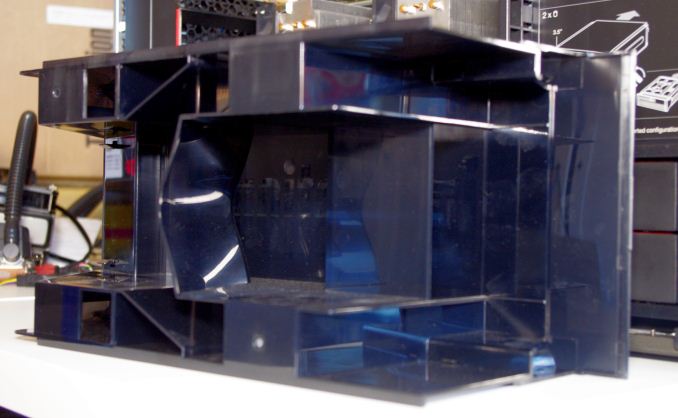
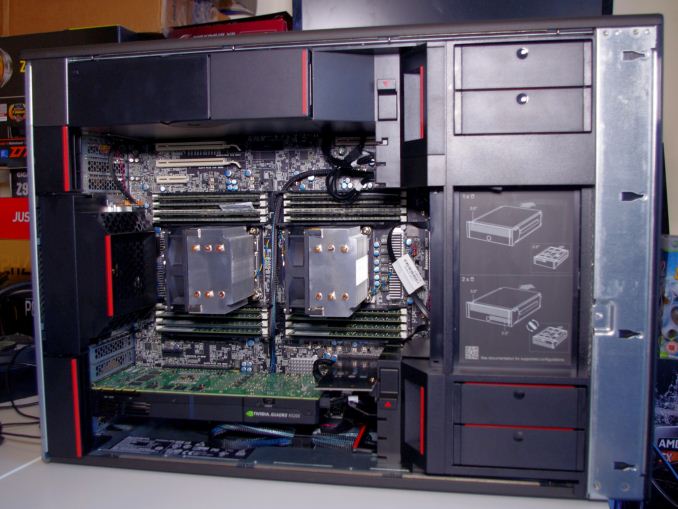
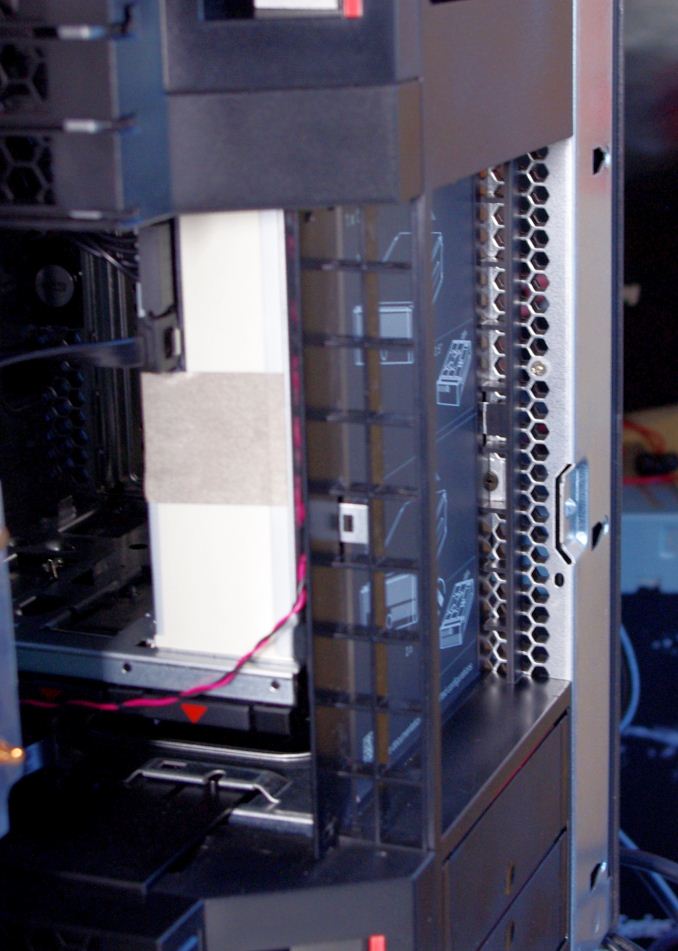
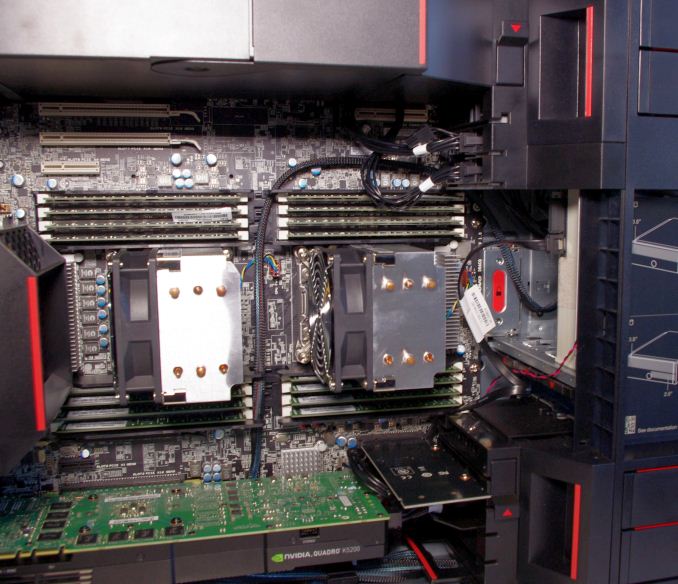
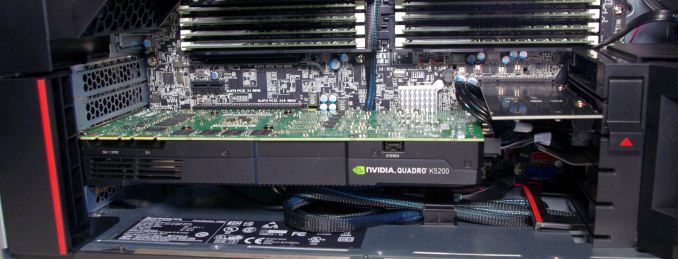

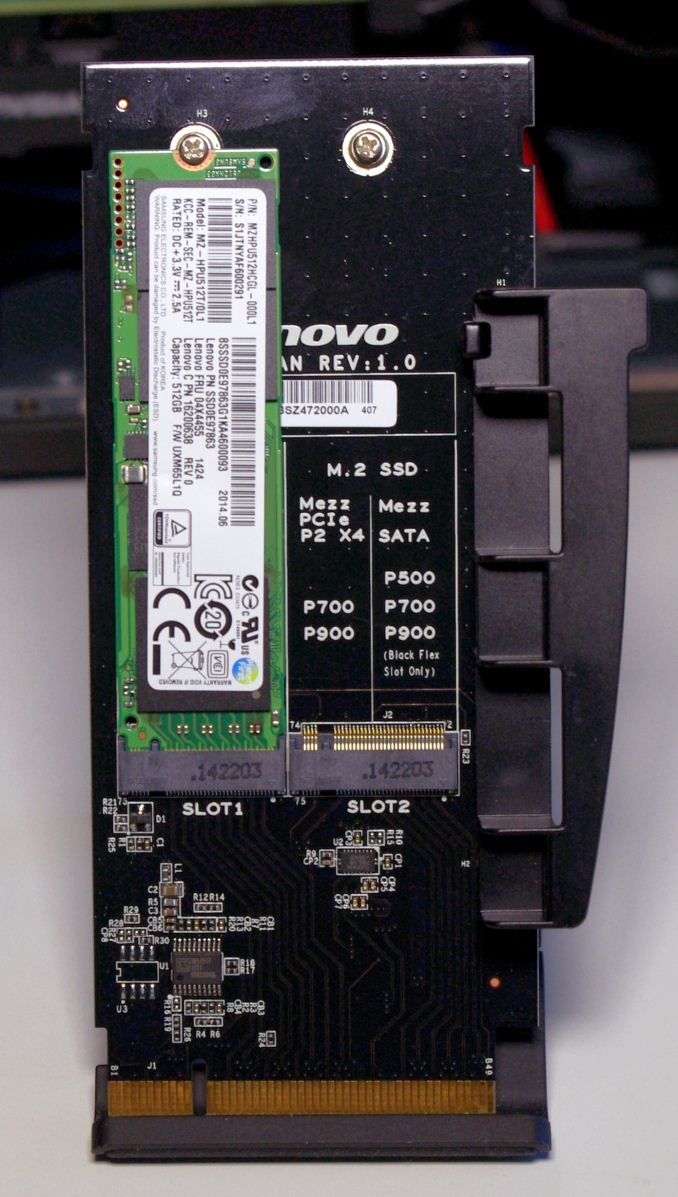

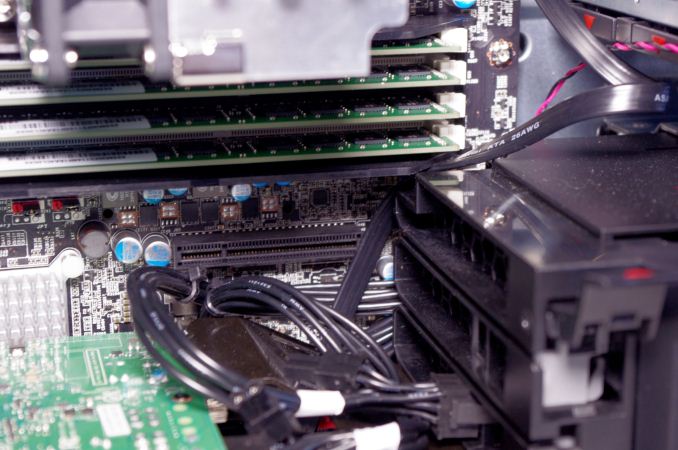
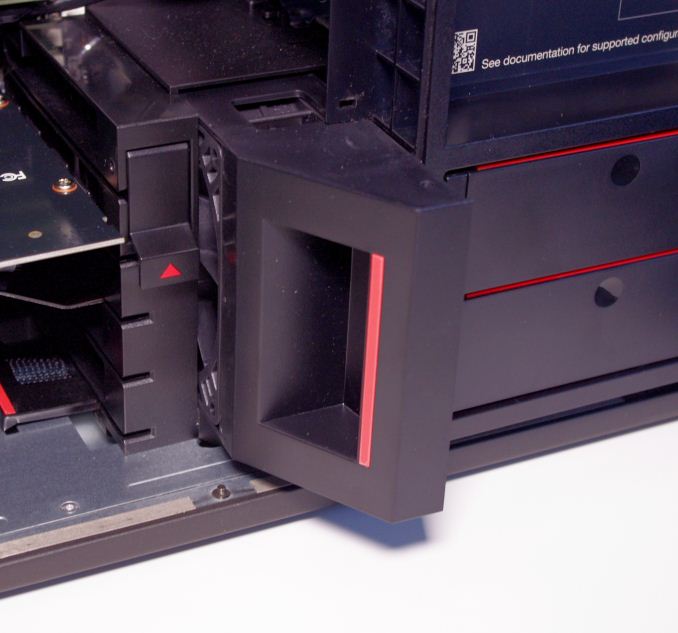
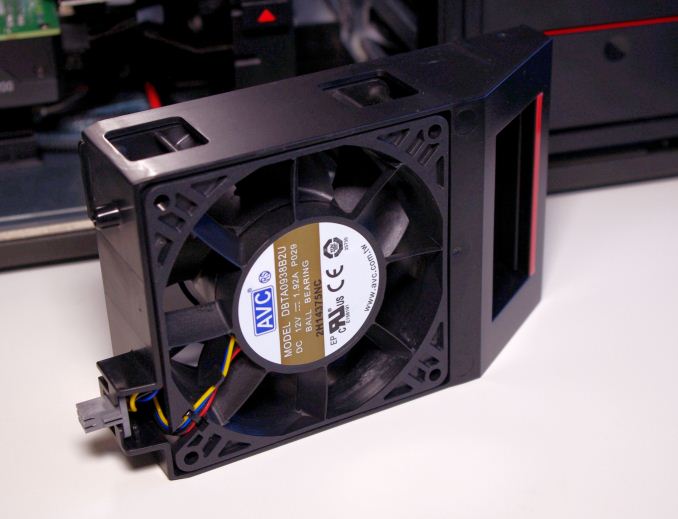
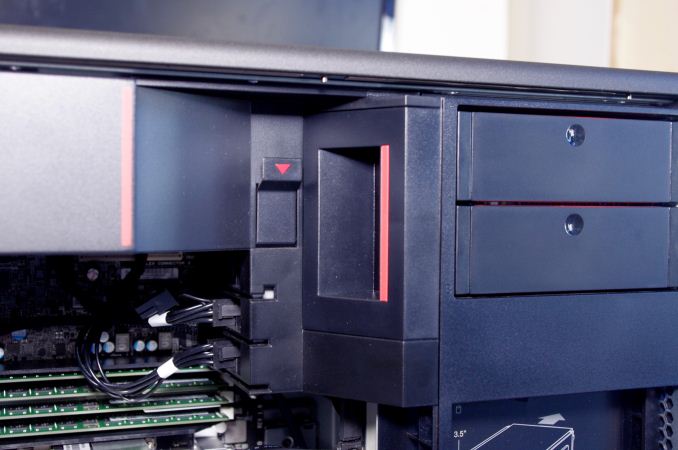
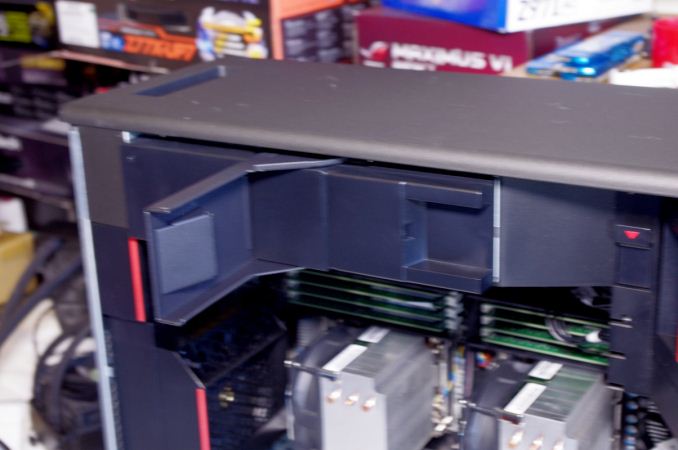
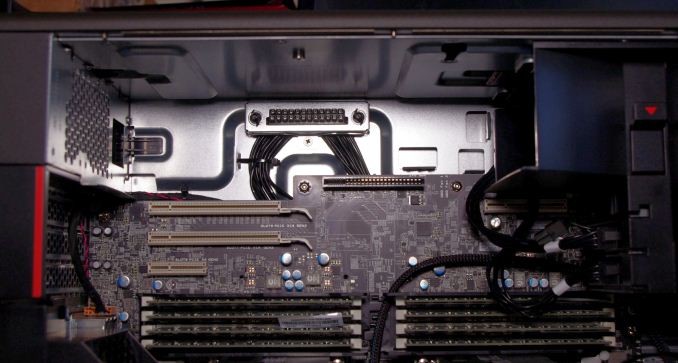
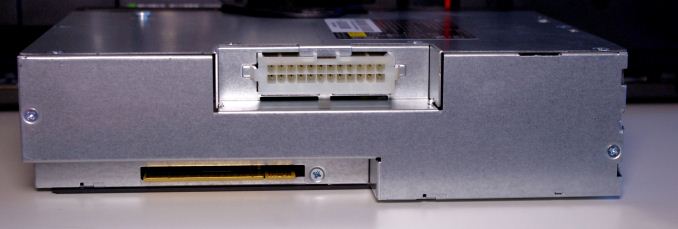
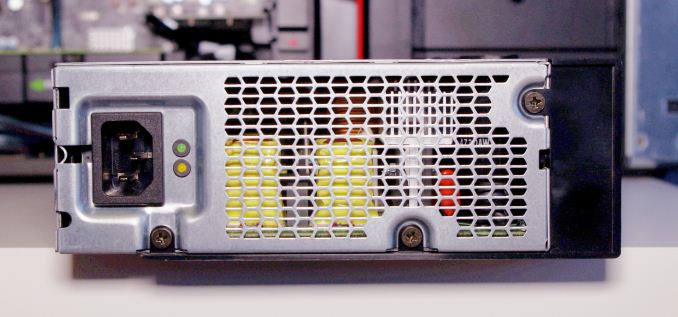
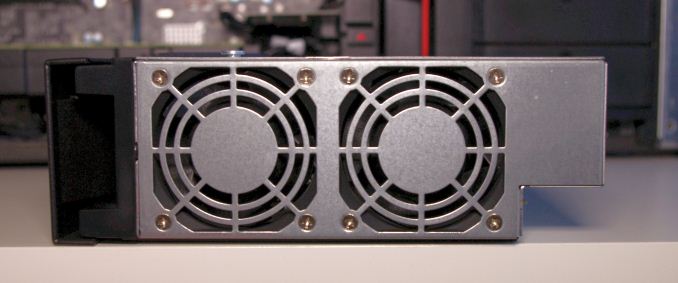
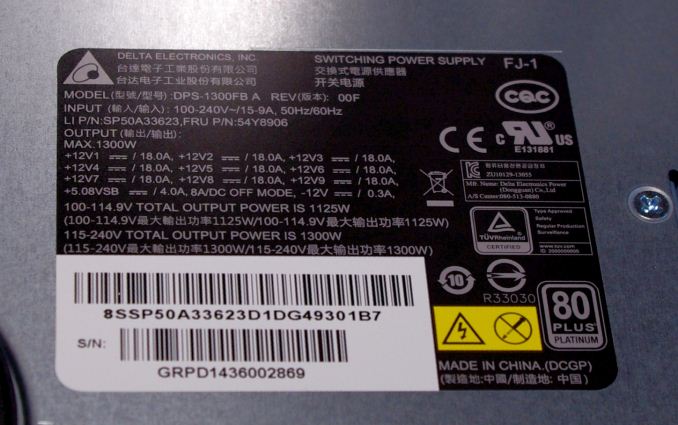
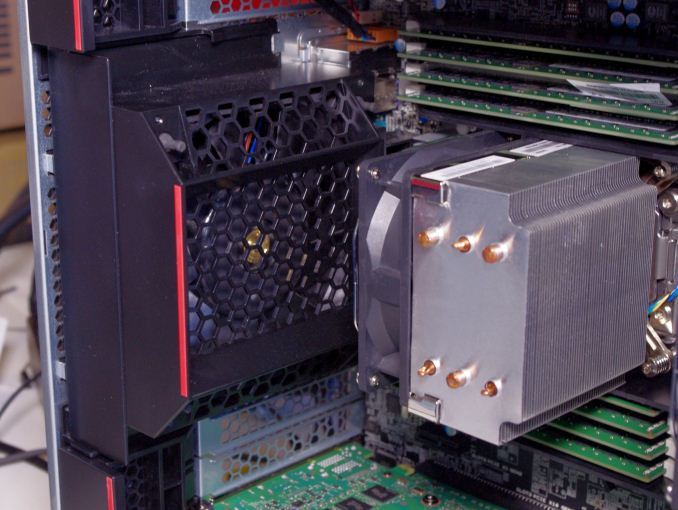
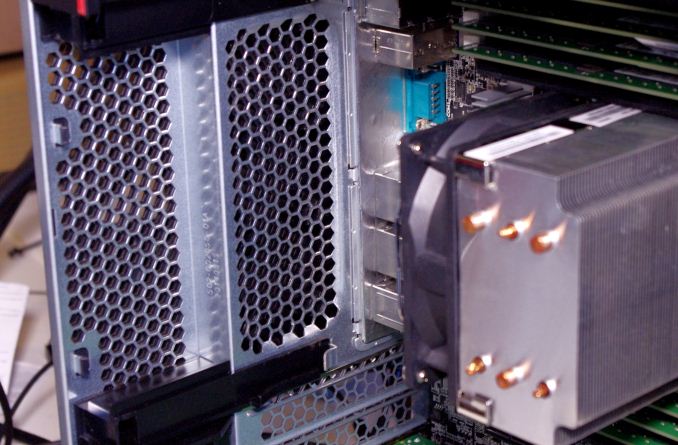
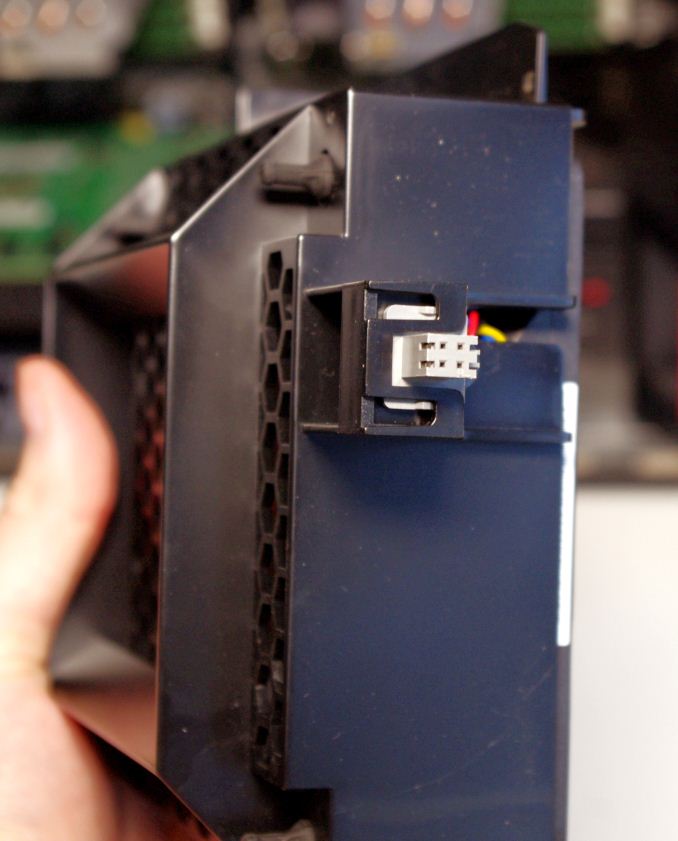
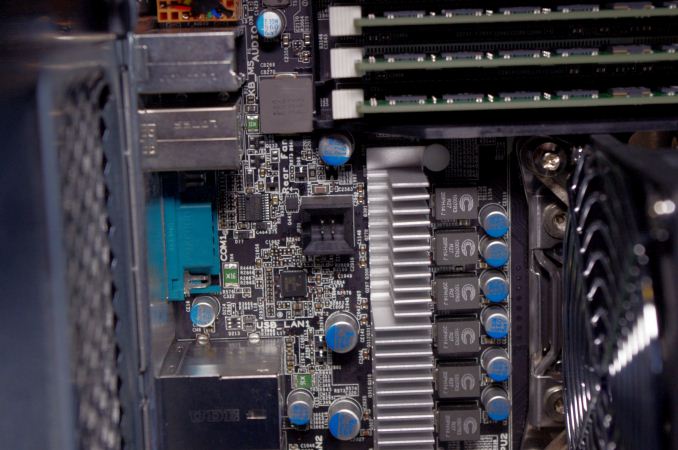

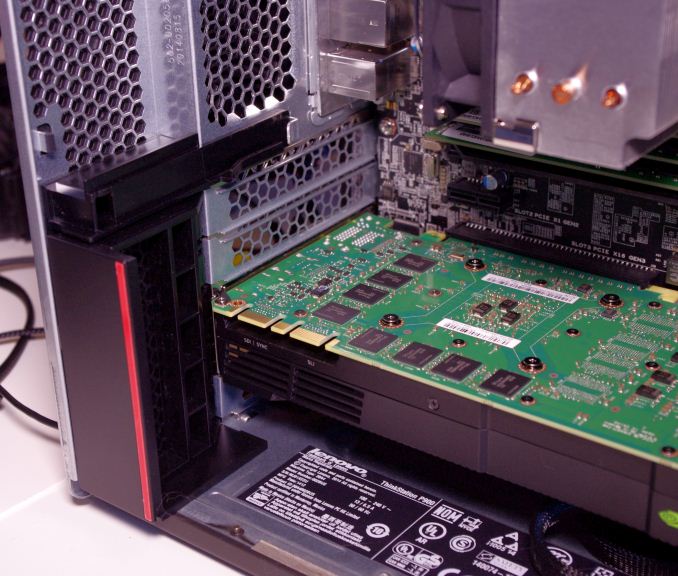
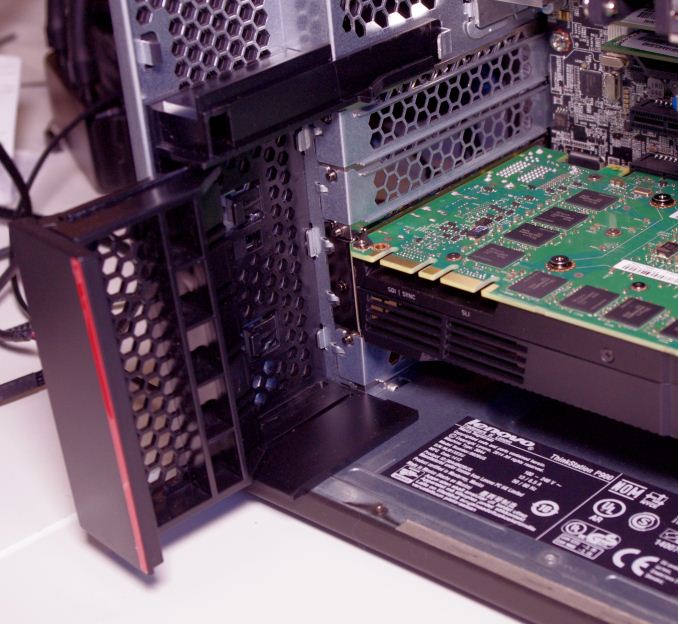
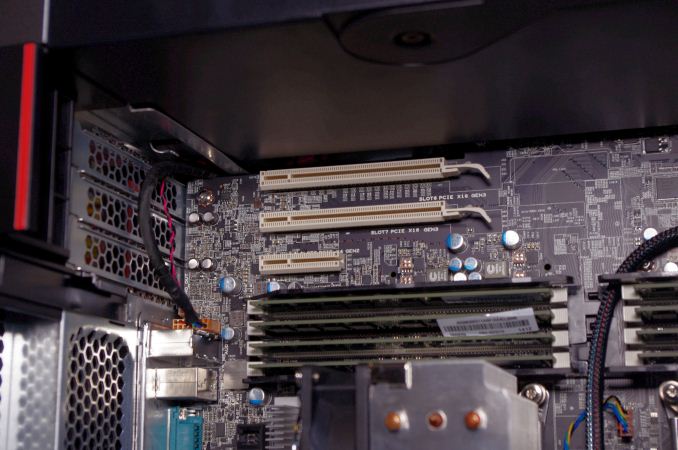

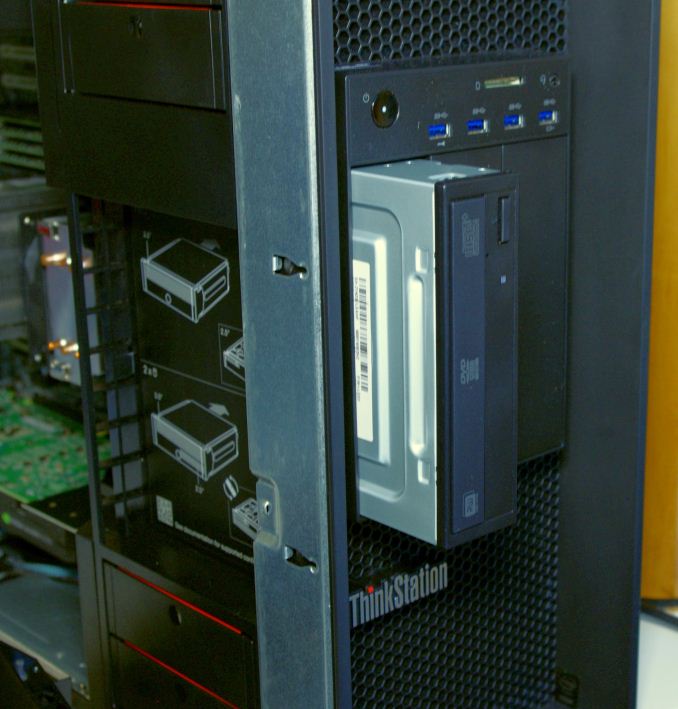
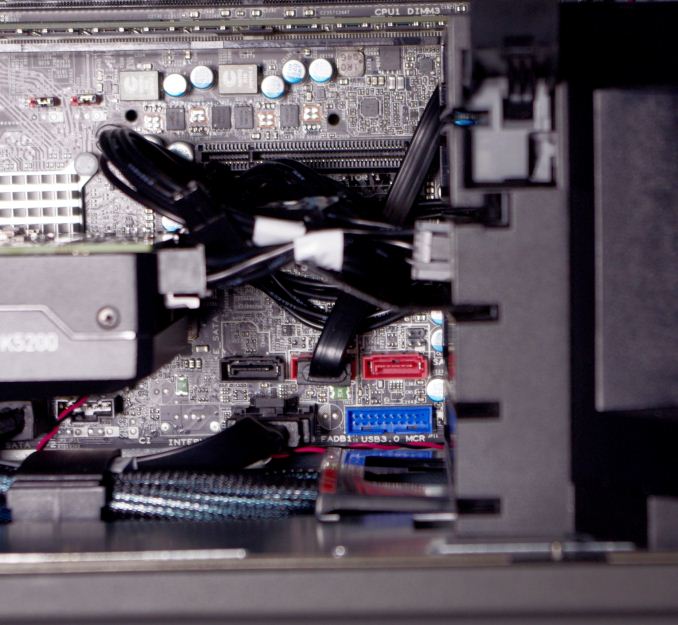

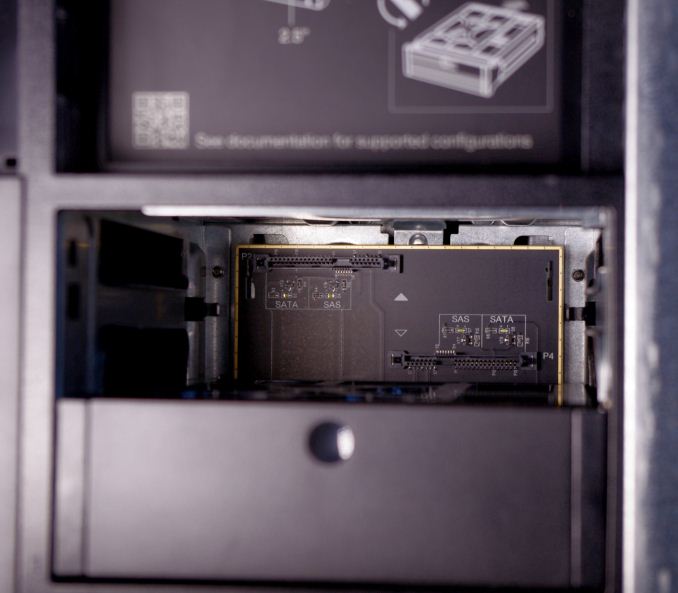
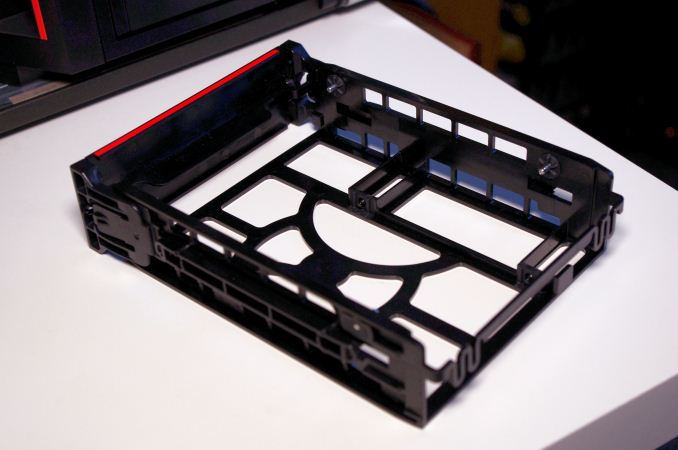

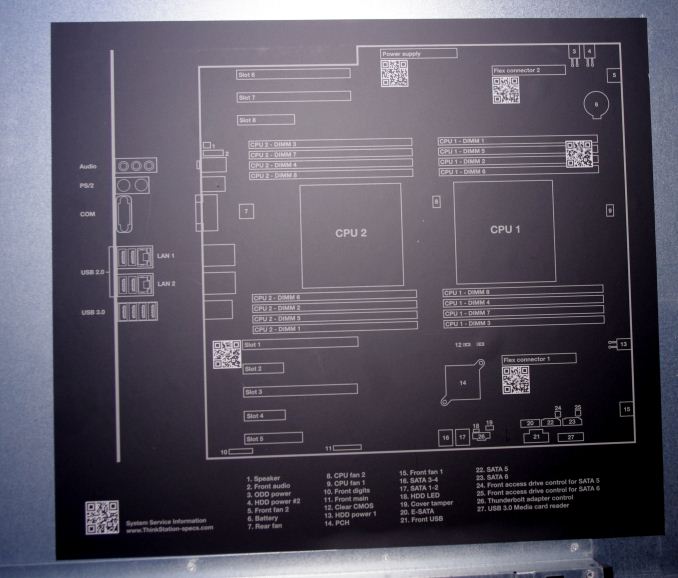







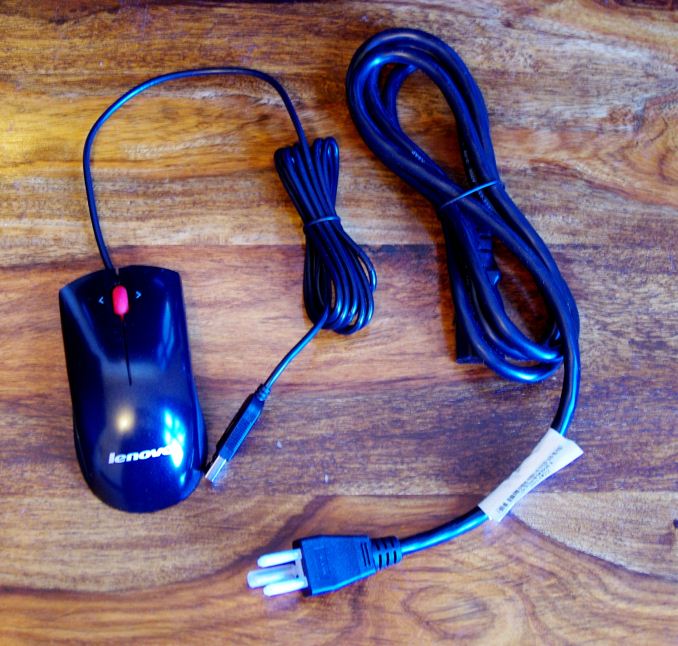
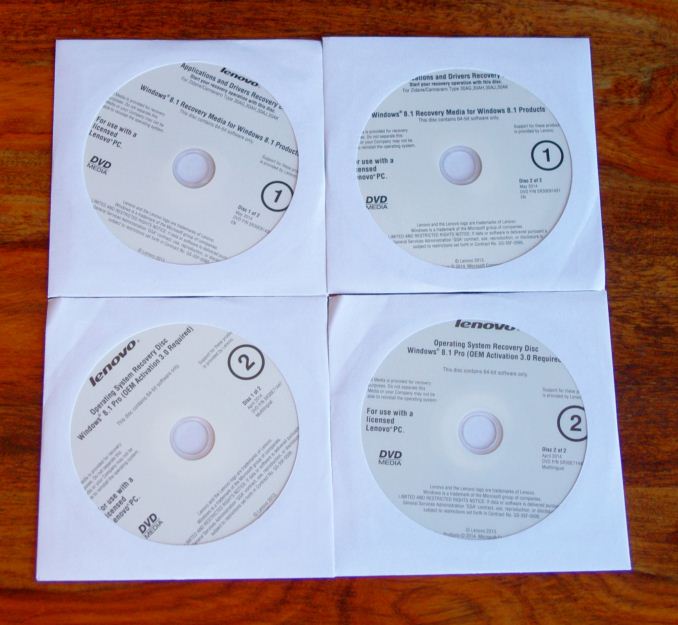








61 Comments
View All Comments
Freakie - Thursday, May 7, 2015 - link
Actually in my experience we do the vast majority of the servicing ourselves, especially for desktops. Literally all I have to do is live chat with Dell's support for IT Departments, tell them that a computer we recently received had the power connector going into the DVD drive break off inside the DVD drive some how, and they next day ship me a replacement PSU and my user has a working DVD drive within 24hrs. And THAT'S what good manufacturer support is, a trusting relationship between manufacturer and IT Department goes a long ways. Sending out equipment for repairs is slow and a pain. And having someone come on-site is a waste of money for the manufacturer and time for us because we need to make sure we are available when they get there instead of repairing it on our own schedule. If you're a "real IT department" for a few hundred computers, you really can't afford the time to have someone else do the repair work.And you'd also be surprised how many things that SHOULD have been EoL'd don't get EoL'd! Just because it isn't under warranty doesn't mean we want to just throw it out especially when you have 100 of the same thing (aka spare parts which means immediate repairs). And some departments are happy with what they have and don't want to go by the set EoL schedule for their computers and use their funds elsewhere. They pay for it with extra downtime when something does break, but they know that it's their own fault.
Samus - Friday, May 8, 2015 - link
My HP servers, workstations and printers order parts that fail\deplete automatically. When I show up to work the next morning at 8AM, the support technician that arrived at 6AM is walking out the door and everything is fixed.That's real support. And it's included with every HP Elitedesk/Elitebook, Laserjet Pro\Officejet Pro, and Proliant server I've ever managed for 3 years unless you purchase a "smartbuy" with a 1y/1y. The craziest thing about HP warranties is the ADP (accidental damage protection) is only 6%/year the cost of the machine. So a $1000 Elitebook is <$200 to cover for 3 years against user destruction. The equivalent Applecare on a $1000 Macbook is $269, and Lenovo charges $229 with no option for next-day.
zavrtak - Friday, May 29, 2015 - link
Small business solutions without internal it department often likes easy to service, replace and upgradeable hardware. Not only because those solutions might offer good value for their money in small business solutions, but as well because external IT consulting likes to make a buck with their own support.Besides that you are absolutely right. If there is a real IT department than usually they prefer to buy support, reliability and just cycle out stuff that stop working - with a few exceptions when old hardware is needed for special use-cases or getting some time for bigger rollouts.
KAlmquist - Wednesday, May 6, 2015 - link
I don't think that the system is particularly hard to service. To remove the power supply (and only the power supply), you remove the side panel, open a door, and slide the power supply out. I assume that the Dell has something that keeps the power supply from accidentally falling out of the case when the side panel is removed, so I would think that remove the power supply from the Dell takes the same number of steps, or more.To access the DIMM's you remove the side panel and the central baffle. Removing the baffle is an extra step, but before we can say definitively that the Dell wins on this measure we would have to compare the time to remove the side panel on both systems.
As for fans that slide in and out, I'll grant you that fans don't fail very often, but if one ever does fail the Lenova allows you to slide out the failed fan and slide in a replacement after removing nothing other than the side panel.
I agree with you about price. I couldn't find a comparable computer on the Dell web site, but AVA Direct will sell a comparable computer for a tad over $10,000. The P900 is only worth considering if you need a large numbers of workstations and can get Lenovo to agree to a large quantity discount.
Freakie - Thursday, May 7, 2015 - link
That's the problem though, being built for too many "what if's". And I hate break-out boards in units too, they are notorious for dying and don't really serve a purpose that a different internal design can't solve. The design of the P900 is just so superfluous. Just having the insides look pretty is a waste because no one is looking at the insides, and of course there is no side window. It just screams unnecessary.The Dell Precision 7910 is the one I was referencing in my original comment. I specced it out online and it came out to ~$5,000 less than this and I doubt that you are going to get a $5,000 discount per-unit on these Lenovos. And if you're ordering that large of a volume, might as well ask your Dell rep for a volume discount as well.
dragonsqrrl - Saturday, May 9, 2015 - link
Yep, I did the same and it came out to around 10,500-$11,000. Based off of this review I too prefer the internal layout of the latest Precisions, they're simple and well thought out. Definitely an improvement over the prior design at least.edlee - Wednesday, May 6, 2015 - link
I have had great experience with Lenovo professional products, thinkserver tower and rack servers similar well thought design and high end power supply. Please try to review an 8 bay thinkserver as well so we can compare to commercial 8 bay naszachrohlfs - Wednesday, May 6, 2015 - link
Would really appreciate some benchmark scores from programs like Solidworks, Revit, Adobe Suites and graphic design programs.While the review is nice it makes it hard to sell anything to a company with out some comparable data on the programs you use.
mapesdhs - Wednesday, May 6, 2015 - link
PS. Ian, pleeeease stop using the Blinkenlights site for the C-ray link! :D I don't control that site, it's just a mirror. The main C-ray link should be here:http://www.sgidepot.co.uk/c-ray.html
Sometimes I can't even connect to Blinkenlights.
Ian.
gey27 - Wednesday, May 6, 2015 - link
The advertising on the sides of the page is extremely off-putting. The ad is so close to the article text that it is making the article difficult to read. I have been coming to this site religiously since before the days of the celeron (the abit BP6 brings back many fond memories) and almost all my computer related purchases are based in part on reviews here. But this latest style is a bridge too far. Please fix it, or I'll be forced to look elsewhere.....